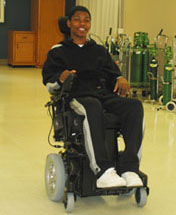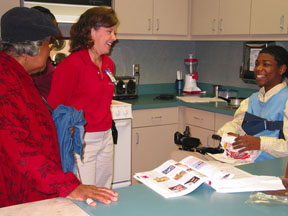JACKSON, Miss.—As Robert Cassidy wraps his right hand around the joystick of a power wheelchair, he acts as nonchalant as a kid playing “Need for Speed” on his Nintendo.
“How fast can I go?” he asks Methodist Rehabilitation Center physical therapist Allison Fracchia, as she fits his lanky frame into the sleek chair.
“Six miles per hour” is her answer, a reply that prompts a wry observation from Cassidy’s aunt Birteen Burnside. “I can just hear his principal saying: ‘Cassidy, no running in the halls,’ ” Burnside says.
It’s a given that the outgoing 16-year-old will put the customized chair through its paces. The Ruleville Central High School junior is determined to reclaim the life he had before Sept. 1 – the night he broke his neck during the first play of his second high school football game.
After learning he was paralyzed from the chest down – in a newspaper headline, no less – Cassidy admits he fell into a two-week funk. But staying down isn’t his style. “Whatever life throws at you, you’ve just got to roll with it,” he says. “You can’t question God. There is a purpose for everybody.”
Cassidy’s new purpose appears to be a starring role as the inspirational Comeback Kid.
Methodist Rehab staffers say Cassidy spent his time at the Jackson hospital motivating patients and employees alike with his hard work and good humor.
”They saw this 16-year-old kid going through this horrible thing, yet he was smiling and dealing with it,” said Jennifer Montgomery, Cassidy’s physical therapist during his more than two-month hospital stay. “When he would finish his therapy, he would befriend the people on the stroke floor.
By the time he left, everybody knew him. He seemed to have a really good heart.”
Cassidy’s nurturing nature also calmed family members, who were initially devastated by the sight of the active athlete lying motionless in his bed.
“When I first got to the hospital, I panicked for a minute,” said Cassidy’s cousin Cheryl Burnside of Cleveland, a constant by his side since the accident. “But Robert said: ‘Tell her I’m alright, and don’t cry.’ I had to go get myself together then.”
As word got out about Cassidy’s courage, visitors flocked to Methodist Rehab to meet the plucky teen – NFL stars Deuce McAlister and Fred Smoot among them.
Football players and cheerleaders from across Mississippi brought signed footballs, jerseys and collected donations in his name. And Madison Central High Head Football Coach Bobby Hall stopped by every Friday with one of Cassidy’s favorite foods -- Kentucky Fried chicken strips. “I’ve been so touched by his attitude,” Hall said.
Hall said Cassidy’s paralyzing collision with another player is something coaches “hope and pray never happens.” But it is a definite risk of the sport. The National Center for Catastrophic Sports Injury Research reports that 256 players sustained disabling cervical cord injuries from 1997 through 2005 – including a dozen in 2004.
To prevent such tragedies, coaches teach players to tackle with their heads up and to never use their helmets as battering rams. But the instructions are easy to forget in the heat of a game. “You don’t really think about it until after it happens,” Cassidy says. Then there’s nothing left to do but put on your game face and get over it. “You don’t give up and lay down on your back all day.”
That’s especially true at Methodist Rehab, where the experienced spinal cord injury team is adept at motivating patients to push themselves. With their help, Cassidy soon reclaimed taken-for-granted skills like brushing his teeth and pulling a shirt over his head – a definite coup for a kid who has always been defined by a warm smile and a meticulous appearance.
To regain the strength and dexterity he needed for a return to the classroom, Cassidy worked three or four hours a day in the therapy gym. His lack of finger function meant he had to learn special maneuvers to be able to make a phone call, write or use a computer. But by the time he left, he was even text messaging friends.
Occupational therapist Suzanne Colbert said Cassidy benefited from being at a hospital that specializes in spinal cord injury, and not just because of the expertise of the staff. “When you are around other spinal cord injury patients, that is a huge part of the acceptance process. We can tell people every day you can do this or do that, but until they see someone else doing it, it’s hard for them to believe.”
Colbert said Cassidy’s positive outlook was another key to his recovery. “He never seemed to be angry, and he had a peace and acceptance about him. He knew God had a plan for him.”
Cassidy says he has kept the thought: “I can do all things through Christ who strengthens me.” Still, he couldn’t help but feel a bit nervous as he left the protected environment of rehab.
As he made his good-bye rounds, Cassidy got everyone to sign a jersey that he had air-brushed with the hospital’s logo – a symbol that combines a lamp of knowledge and hand of healing to form a dove.
The dove represents the triumph of the human spirit, a concept Cassidy came to personify. “I don’t think about the possibility of not walking,” he says. “But if that happens to be, I’ll just deal with it. I’m going to be me regardless.”


